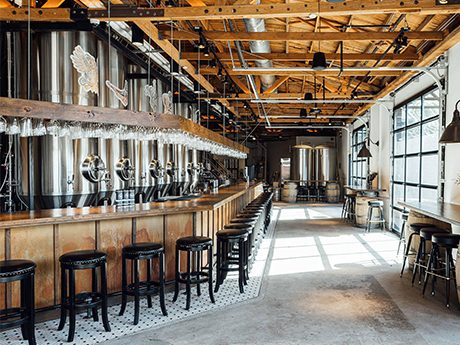— By Evan Jurgensen, Senior Vice President, Lee & Associates Los Angeles – Downtown —
As the pandemic recedes, the hospitality and food and beverage industries in downtown Los Angeles are rebounding, driven in part by the return of venue entertainment and conferences. The number of visitors to the area has climbed back to within 10 percent of pre-pandemic levels and now sits at 10 million people per month. Consequently, there has been an influx of new restaurants, venues and breweries in the region.
However, as overall occupancy levels in the market remain in flux, businesses are becoming mindful of how they utilize their spaces to achieve a triple bottom line impact that benefits not only the asset owner, but also the consumer and community at large for the long run.
Increased Investment in Outdoor Space
Outdoor dining saved many restaurants during the pandemic and continues to have great appeal in the present day. In addition to being a healthier option for diners, outdoor seating allows restaurants to handle more customers at once and increase profitability.
Los Angeles city officials created a streamlined process known as the L.A. Al Fresco program in May 2020, which allowed more than 2,500 restaurants and bars to quickly expand dining areas into the street, sidewalk and private lots adjacent to their establishments. Such a process would normally take months of navigating paperwork and bureaucracy, as well as tens of thousands of dollars in fees.
When news broke earlier this year of the program potentially concluding as pandemic restrictions come to an end, Angelenos made it clear outdoor dining is here to stay. As a result, businesses are prioritizing areas with more patio space or finding ways to create them within their existing footprint, such as converting parking spaces into dining areas. This trend showcases an innovative adaptive reuse approach that continues to gain traction in the food and beverage industry.
Ghost Kitchens Continue to Rise in Popularity
The rise of ghost kitchens during the COVID era was bolstered by the increased popularity of online ordering, curbside service and mobile food delivery. Post-pandemic, the demand for online ordering services remains strong even in the face of ongoing economic uncertainty: DoorDash and Uber Eats — which together control a combined 96 percent of the food delivery market — reported revenues of $6.58 billion and $11 billion, respectively, in 2022.
They are more prevalent than ever in Downtown Los Angeles, where space has always been at a premium. Restaurant owners are leaning heavily into the concept, which allows them to operate on a leaner business model while still being able to offer takeout and delivery. Although ghost kitchens are more expensive per square foot, their plug-and-play nature is highly appealing and allows tenants to hit the ground running with new business quickly. In contrast, building out a traditional kitchen and obtaining the necessary permits can take up to 18 months to complete. Rising construction costs also make the ghost kitchen model a more cost-effective option compared to building out a traditional kitchen for many tenants.
Rethinking Brewery Spaces
The abundant Los Angeles craft beer scene, which is notoriously expensive to conduct business in, has recently been rocked by the sudden closure of several well-respected craft breweries in the county, including Mumford Brewery and Modern Times in Downtown LA.
Some brewery owners are rethinking their business models as the costs of construction materials and labor continue to rise faster than their profits. A few owners are choosing to focus on lucrative taprooms and restaurants, while others are pivoting toward models that allow them to focus solely on beer production and distribution.
From a real estate perspective, this offers asset managers an opportunity to provide unique multi-tenant spaces similar to ghost kitchens that would allow brewers to manufacture, store and distribute their product with a significantly smaller footprint and lower overhead costs.
Tackling the Bigger Issues
While the food and beverage industry as a whole has shown remarkable resilience, its continued growth and success in Downtown Los Angeles depend on increased occupancy. The office market remains uncertain due to the ongoing prevalence of hybrid work, and while the visiting and residential populations helped to sustain the area during the pandemic, they are not a reliable long-term solution. For the food and beverage industry and the overall economy of Downtown to thrive, the office market must rebound and bring in more people to the area.


